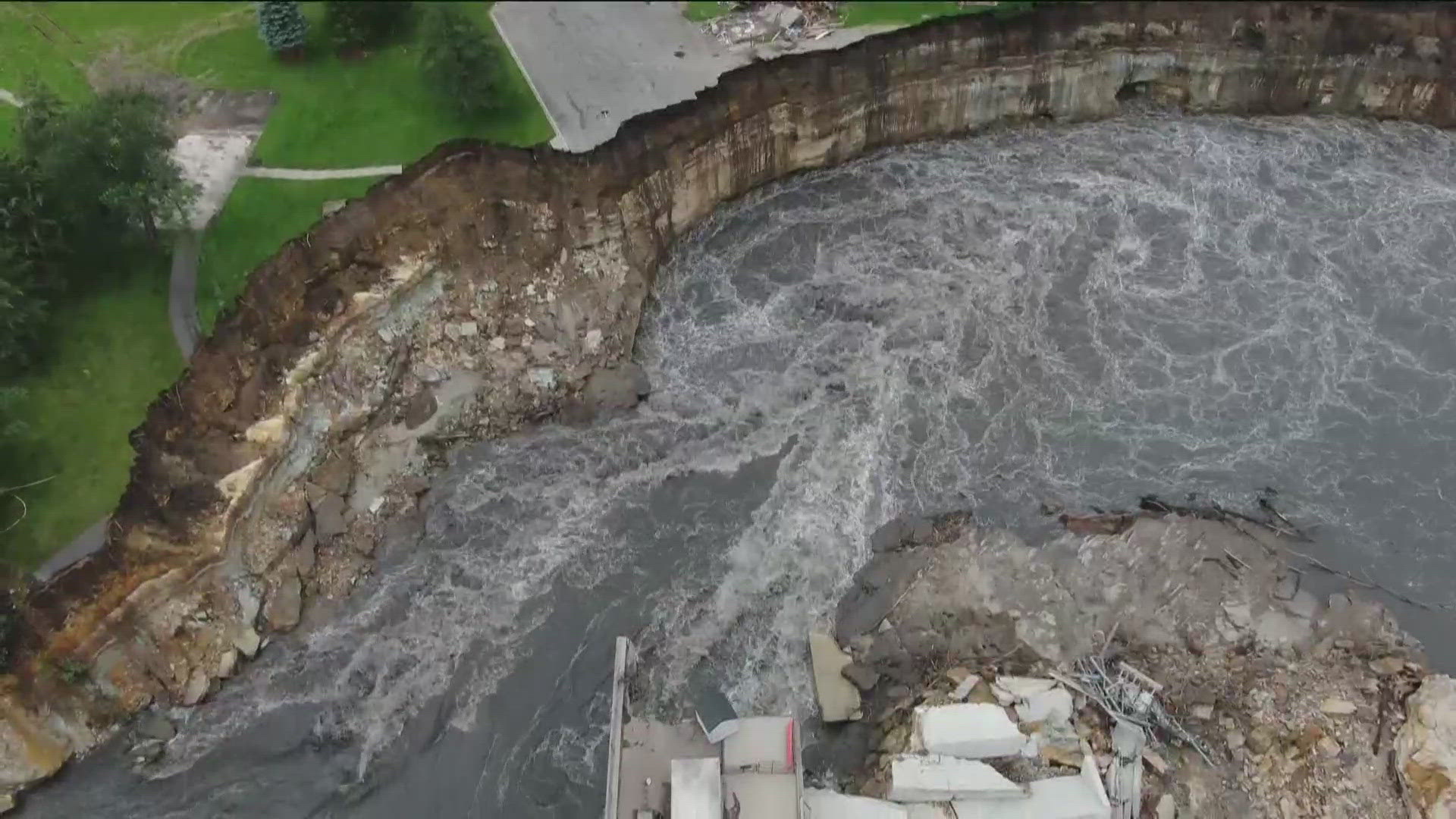MANKATO, Minn. — A week after the rain-swollen Blue Earth River surged around the Rapidan Dam, nature's wrath is clearly evident. A large section of the western bank is missing, and the adjacent Blue Earth County Highway 9 bridge has been closed.
Governor Tim Walz traveled there Tuesday to get a closer look at the aftermath and thank emergency preparedness and public works leaders for their efforts to keep the public safe amid historic flooding.
"And I can’t give enough thanks to the folks, making good decisions, stabilizing the situation, and then simultaneously started thinking about what does recovery look like," Walz told reporters.
The river level has dropped, but it’s still cutting away at the banks, and the sandstone the County 9 bridge piers sit upon, which is why the bridge is closed and may need to be replaced.
"As we’re seeing dramatic levels of reiver head cutting, as the river’s lowering itself down and washing away tremendous amounts of sediment we’re losing stability," Blue Earth County Public Works Director Ryan Thilges explained.
He said some rock had been brought into temporarily support one of the bridge's tiers, but the current was still too strong to consider bolstering a second pier that may be compromised.
The site is now known worldwide, thanks to a viral video of the Hruska Family's home falling into the river. The roiling waters were also threatening the family's Rapidan Dam Store, so the county purchased the building and demolished it to keep it from falling into the river.
"We saved everything out of the store that was in there, from booths to the bar, I mean, you walk inside and there was nothing left," David Hruska told KARE.
"When we’re able to open back up, we have parts of the Dam Store that we will put back into our new place. You’ll still get the feel from the old Dam Store when you come and visit us."
David Hruska’s father, Jim, ran the store, which sat on a two-acre lot, since 1972. Now the store, the house, and most of the land is gone.
"He's doing better than I thought. I’m surprised at how he’s handling it. We’ve had a lot of friends and family around us, and that really helps," the younger Hruska remarked.
He said he didn't see the house go into the river but got as much out of it as he could before that night.
"I'm still thinking of things I should've gotten out of the house, but the main thing is that we all have our lives. Nobody was hurt."
Governor Walz met with the Hruska family privately in a mobile command trailer near the dam site, prior to addressing the media.
"He just wanted to know how were doing mostly, just making sure we were all right and could offer assistance."
David Hruska and his father are staying with David’s sister, Jenny Barnes, for now, but the long-term dream is to rebuild a home and a store in the Blue Earth River Valley. A GoFundMe has been set up to help the family.
"The first three days you’re wondering if your house is going to be there when you wake up in the morning. And then your house goes and then you think about the store. Now our buildings are all gone, so I'm sleeping a little better," Hruska explained.
"But still are worried about our future. We still want to rebuild. That’s our plan, but that’s a long way down the road."
Blue Earth County Commissioner Kevin Paap said it's hard to explain to outsiders how important the store was to locals.
"The Dam Store, the burgers and malts, the pies, and the walkout to the dam provided many special memories not only for our family, but many others," Paap recalled.
"Seeing this today puts a hole in many of our hearts. Our thoughts and prayers are to the Hruska family and friends through this difficult and overwhelming time."
So far 22 counties have presidential declarations setting them up for federal disaster relief, while 25 other counties may have to rely on state disaster aid. Those assessments are still underway, according to Public Safety Commissioner Bob Jacobson.
"As many of you are aware, flooding is still going down in many areas," Jacobson told reporters.
"To get a full damage assessment of those areas we need those flood waters to be able to go down to be able to do that."
He said the state of emergency declaration is still in place, and that members of the Minnesota National Guard are still actively assisting with the efforts.
The first wave of federal and state aid is geared toward helping communities pay for repairs to public infrastructure, so that burden doesn't fall entirely on local taxpayers. But Jacobson said some federal programs will also help with private losses, but that money has yet to be made available to the affected cities and counties.

